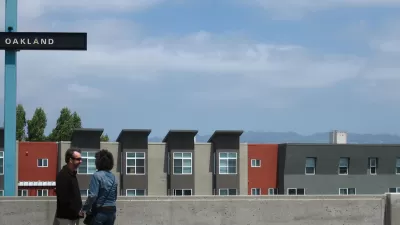As rents in the Bay Area have skyrocketed, cities are updating and introducing rent control ordinances. They are stoking age-old debates over the macroeconomic value of rent control.

"No fewer than eight Bay Area cities — from urban giants like Oakland and San Jose to small suburbs like Lafayette and Pacifica — have considered brand-new or significantly strengthened rent control policies in the past year. Debates over whether to adopt these policies and what form they should take have divided city councils, pit tenants against landlords, and raised perennial questions about the long-term value of an intervention that is considered extreme by many property rights advocates and counterproductive according to many economists."
By one estimate, the Bay Area added over 440,000 private sector jobs between 2010 and 2014 but fewer than 54,000 housing units. Meanwhile, evictions seem to be on the rise. In July, the San Francisco Chronicle reported that the number of monthly evictions in the City of San Francisco, which has rent control, had risen 32 percent over the previous three years' average."
Many ordinances and proposals also restrict evictions to only those that are for “just cause,” so that landlords cannot evict long-term tenants simply to raise the rent on new tenants. In some cases, rent control is governed by an elected rent control board. Cities have struggled, often with nearly violent disputes, to find the right mix of protections for tenants without raising the ire of property owners."
FULL STORY: Rent Control Gains Traction Amid Housing Crisis in Bay Area

Manufactured Crisis: Losing the Nation’s Largest Source of Unsubsidized Affordable Housing
Manufactured housing communities have long been an affordable housing option for millions of people living in the U.S., but that affordability is disappearing rapidly. How did we get here?

Americans May Be Stuck — But Why?
Americans are moving a lot less than they once did, and that is a problem. While Yoni Applebaum, in his highly-publicized article Stuck, gets the reasons badly wrong, it's still important to ask: why are we moving so much less than before?

Using Old Oil and Gas Wells for Green Energy Storage
Penn State researchers have found that repurposing abandoned oil and gas wells for geothermal-assisted compressed-air energy storage can boost efficiency, reduce environmental risks, and support clean energy and job transitions.

Greening Oakland’s School Grounds
With help from community partners like the Trust for Public Land, Oakland Unified School District is turning barren, asphalt-covered schoolyards into vibrant, green spaces that support outdoor learning, play, and student well-being.

California Governor Suspends CEQA Reviews for Utilities in Fire Areas
Utility restoration efforts in areas affected by the January wildfires in Los Angeles will be exempt from environmental regulations to speed up the rebuilding of essential infrastructure.

Native American Communities Prepare to Lead on Environmental Stewardship
In the face of federal threats to public lands and conservation efforts, indigenous groups continue to model nature-centered conservation efforts.
Urban Design for Planners 1: Software Tools
This six-course series explores essential urban design concepts using open source software and equips planners with the tools they need to participate fully in the urban design process.
Planning for Universal Design
Learn the tools for implementing Universal Design in planning regulations.
Heyer Gruel & Associates PA
City of Moreno Valley
Institute for Housing and Urban Development Studies (IHS)
City of Grandview
Harvard GSD Executive Education
Salt Lake City
NYU Wagner Graduate School of Public Service
City of Cambridge, Maryland





























